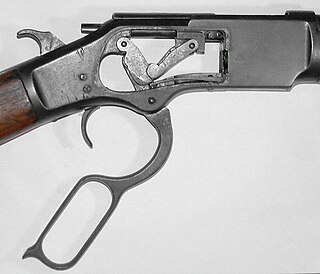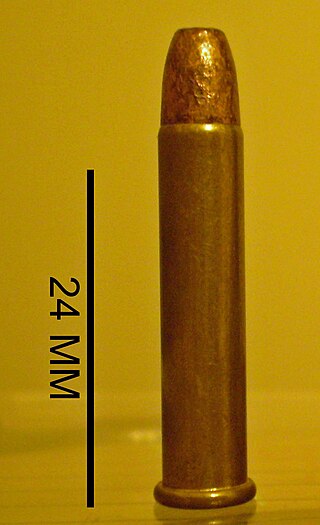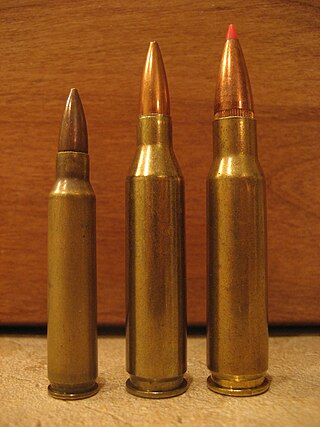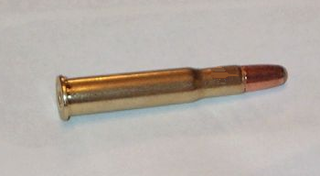
In firearm designs, the term single-shot refers to guns that can hold only a single round of ammunition inside and thus must be reloaded manually after every shot. Compared to multi-shot repeating firearms ("repeaters"), single-shot designs have no moving parts other than the trigger, hammer/firing pin or frizzen, and therefore do not need a sizable receiver behind the barrel to accommodate a moving action, making them far less complex and more robust than revolvers or magazine/belt-fed firearms, but also with much slower rates of fire.

In firearms terminology, an action is the functional mechanism of a breech-loading firearm that handles the ammunition cartridges, or the method by which that mechanism works. Actions are technically not present on muzzleloaders, as all those are single-shot firearms with a closed off breech with the powder and projectile manually loaded from the muzzle. Instead, the muzzleloader ignition mechanism is referred to as the lock.
Winchester rifle is a comprehensive term describing a series of lever action repeating rifles manufactured by the Winchester Repeating Arms Company. Developed from the 1860 Henry rifle, Winchester rifles were among the earliest repeaters. The Model 1873 was particularly successful, being marketed by the manufacturer as "The Gun That Won the West".

A lever action is a type of action for repeating firearms that uses a manually operated cocking handle located around the trigger guard area that pivots forward to move the bolt via internal linkages, which will feed and extract cartridges into and out of the chamber, and cock the firing pin mechanism. This contrasts to other type of repeating actions such as the bolt-action, pump-action, semi-automatic, fully automatic, and/or burst mode actions. A firearm using this operating mechanism is colloquially referred to as a levergun.
Pump action is a type of manual firearm action that is operated by moving a sliding handguard on the gun's forestock. When shooting, the sliding forend is pulled rearward to eject any expended cartridge and typically to cock the hammer or striker, and then pushed forward to load a new cartridge into the chamber. Most pump-action firearms use an integral tubular magazine, although some do use detachable box magazines. Pump-action firearms are typically associated with shotguns, although it has been used in rifles, grenade launchers, as well as other types of firearms. A firearm using this operating mechanism is colloquially referred to as a pumpgun.

The .22 Winchester Magnum Rimfire, also known as the .22 WMR, .22 Magnum, .22 WMRF, .22 MRF, or .22 Mag, is a rimfire cartridge. Originally loaded with a bullet weight of 40 grains (2.6 g) delivering velocities in the 2,000 feet per second (610 m/s) range from a rifle barrel, .22 WMR is now loaded with bullet weights ranging from 50 grains (3.2 g) at 1,530 feet per second (470 m/s) to 30 grains (1.9 g) at 2,200 feet per second (670 m/s).
The Remington Model 7600 is a series of pump-action centerfire rifles made by Remington Arms. The Model 7600 is a progression from the original Model 760 pump-action rifle which Remington produced from 1952 to 1981. Production of the Model Six began in 1981 and was discontinued in 1987. Production of the Sportsman model 76 began in 1985 and was discontinued in 1987. Production of the model 7600 began in 1987 and was discontinued in 2020.
The Winchester Repeating Arms Company was a prominent American manufacturer of repeating firearms and ammunition. The firm was established in 1866 by Oliver Winchester and was located in New Haven, Connecticut. The firm went into receivership in 1931 and was bought by the Western Cartridge Company, a forerunner of the Olin Corporation. The Winchester brand name is still owned by the Olin Corporation, which makes ammunition under that name. The Winchester name is also used under license for firearms produced by two subsidiaries of the Herstal Group – FN Herstal of Belgium and the Browning Arms Company of Ogden, Utah.

The .243 Winchester (6×52mm) is a popular sporting rifle cartridge. Developed as a versatile short action cartridge to hunt both medium game and small game alike, it "took whitetail hunting by storm" when introduced in 1955, and remains one of the most popular whitetail deer cartridges. It is also commonly used for harvesting blacktail deer, pronghorns and mule deer with heavier rounds, and is equally suited to varmint hunting with lighter rounds. The .243 is based on a necked down .308 Winchester, introduced only three years earlier. Expanding monolithic copper bullets of approximately 80 to 85 grains or traditional lead rounds of 90 to 105 grains with controlled expansion designs are best suited for hunting medium game, while lighter rounds are intended for varmints.
Marlin Firearms is an American manufacturer of semi-automatic, lever-action and bolt-action rifles. In the past the company made shotguns, derringers, and revolvers. Marlin owned the firearm manufacturer H&R Firearms. In 2007, Remington Arms, part of the Remington Outdoor Company, acquired Marlin Firearms. Remington produced Marlin-brand firearms at its Kentucky and New York manufacturing facilities. In 2020, Sturm, Ruger & Co. bought the Marlin business from bankrupt Remington Outdoor Company.

The .30-30 Winchester cartridge was first marketed for the Winchester Model 1894 lever-action rifle in 1895. The .30-30, as it is most commonly known, along with the .25-35 Winchester, was offered that year as the United States' first small-bore sporting rifle cartridges designed for smokeless powder. Since its introduction, it has been utilized alongside the development of flatter shooting cartridges, most prominently those derived from designs subsidized by interest in military expenditures, yet the .30-30 has remained in widespread use almost entirely because of reliable effectiveness in civilian applications, proven by putting food on the table for millions of people within a practical range of hunting situations.
The Marlin Model 336 is a lever-action rifle and carbine made by Marlin Firearms. Since its introduction in 1948, it has been offered in a number of different calibers and barrel lengths, but is commonly chambered in .30-30 Winchester or .35 Remington, using a 20- or 24-inch barrel. Currently, the model with a 24-inch barrel is only available in .30-30 Winchester. The Model 336 is now back in production as of March 27, 2023.
The Winchester Model 1894 rifle is a lever-action repeating rifle that became one of the most famous and popular hunting rifles of all time. It was designed by John Browning in 1894 and originally chambered to fire two metallic black powder cartridges, the .32-40 Winchester and .38-55 Winchester. It was the first rifle to chamber the smokeless powder round, the .30 WCF in 1895. In 1901, Winchester created the new .32 Winchester Special caliber with production of rifles starting in 1902.

The Winchester Model 1892 was a lever-action repeating rifle designed by John Browning as a smaller, lighter version of his large-frame Model 1886, and which replaced the Model 1873 as the company's lever-action for pistol-caliber rounds such as the .44-40.
Remington Arms Model 600 was a push feed bolt-action rifle produced by Remington Arms from 1964 to 1968. While it is commonly believed that production ended in 1967, according to Remington representatives records indicate that it actually ended in 1968. This Model was the precursor to the Model 660 ; the Model Mohawk 600 ; and the Model 673.

The Colt Lightning Carbine or Colt Lightning Rifle was a slide-action (pump-action) rifle manufactured by Colt from 1884 until 1904 and was originally chambered in .44-40 caliber. Colt eventually made the Lightning Rifle in three different frame sizes, to accommodate a wide range of cartridges, from .22 Short caliber and .38-40 to .50-95 Express. Its profile resembles the pump-action rimfire rifles made by the Winchester Repeating Arms Company and Remington Arms. The Lightning saw use as a sporting arm in America and was adopted for use by the San Francisco Police Department, but was never as popular or as reliable as the various lever-action rifles of its day. It is however reported to have been used by American forces in the Spanish-American War, most likely as privately purchased weapons.

The 6.5mm Remington Magnum is a .264 caliber (6.7 mm) belted bottlenecked cartridge introduced in 1966. The cartridge is based on a necked down .350 Remington Magnum which on turn is based on a shortened, necked down, blown out .375 H&H Magnum case. The cartridge was one of the first short magnum cartridges.

A varmint rifle is a small-caliber precision firearm or high-powered airgun primarily used for both varmint hunting and pest control. These tasks include killing three types of pests or nuisance animals that spread diseases or destroy crops or livestock:
The BSA CF2 is a rifle manufactured by the Birmingham Small Arms Company (BSA).
The Remington Model 572 Fieldmaster is a slide action, manually-operated .22 caliber (rimfire) repeating rifle manufactured by Remington Arms Company. First introduced to the commercial market in 1956, the 572 Fieldmaster rifle incorporates a tubular magazine capable of feeding .22 Short, .22 Long, or .22 Long Rifle rimfire cartridges, a cross-bolt safety, and an aluminum receiver grooved for scope mounts. The original Fieldmaster used a 22.75-inch barrel. The Model 572 uses many of the design features first introduced on the Remington Model 870 shotgun, and replaced the Model 121 Fieldmaster as the company's slide-action rimfire repeater. The 572 was discontinued in 2020 following the bankruptcy of the parent company.










